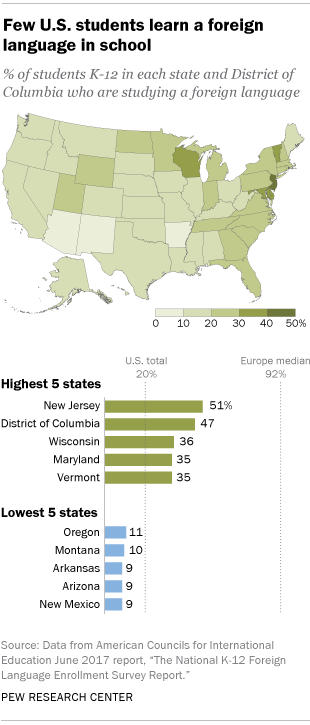
Students Around the World are Learning Multiple Languages: The US is an Exception
All around the world children live in multi-lingual families. Often times students grow up learning 2 to 3 languages as a common practice. However, students across the United States cannot say the same. Only 26% of Americans can speak in another language other than English.
Kat Devlin explores this phenomenon by examining the number of multilingual students in the EU. Read it here:
—
Students throughout the United States and Europe face many similar tasks throughout their education, from preparing for exams to writing papers. But there are glaring differences when it comes to foreign language education – or lack thereof – and the result is that far lower shares of American students study a foreign language.

Learning a foreign language is a nearly ubiquitous experience for students throughout Europe, driven in part by the fact that most European countries have national-level mandates for formally studying languages in school. No such national standard exists in the U.S., where requirements are mostly set at the school district or state level.
Across Europe, students typically begin studying their first foreign language as a required school subject between the ages of 6 and 9. Furthermore, studying a second foreign language for at least one year is compulsory in more than 20 European countries.
Overall, a median of 92% of European students is learning a language in school. Most primary and secondary school students across Europe study at least one foreign language as part of their education, according to Eurostat, the statistics arm of the European Commission. Of the 29 European nations for which data are available, 24 have a foreign language learning rate of at least 80%, with 15 of those reaching 90% or more of students enrolled in language courses. In three of the four countries with the smallest student populations – Luxembourg, Malta, and Liechtenstein – 100% of students are reported to be learning a foreign language.
Even in the European countries with the lowest overall shares of students learning a foreign language, most students learn at least one foreign language before completing secondary school. (To allow for comparison across countries, Eurostat uses three broad education categories – primary, lower secondary and upper secondary – that are roughly the equivalent of primary, middle, and high school in the U.S.)
For example, while Belgium (64%) reports the lowest overall percentage of students learning another language, 90% of Belgian upper secondary students are studying a foreign language in school. This includes 67% who are studying more than one foreign language. In Portugal, where the learning rate is 69% overall, nearly 90% of lower secondary students are enrolled in two or more foreign language courses. Roughly 98% of students in the Netherlands are learning a foreign language by the time they reach lower secondary (or about 7th grade), including 74% learning two or more languages, despite the country’s overall rate of 70%. English is the most studied language across all age ranges in Europe.
 Meanwhile, far fewer K-12 students in the U.S. participate in foreign language education. Throughout all 50 states and the District of Columbia, 20% of K-12 students are enrolled in foreign language classes, according to a 2017 report from the nonprofit American Councils for International Education. New Jersey (51%) has the most students studying a language, followed by the District of Columbia (47%) and Wisconsin (36%). However, the vast majority of states have less than 25% participation, with only 9% of students studying a foreign language in New Mexico, Arizona, and Arkansas. Spanish is overwhelmingly the most popular language studied, though the report also examined languages ranging from Chinese to Latin to accredited online American sign language classes.
Meanwhile, far fewer K-12 students in the U.S. participate in foreign language education. Throughout all 50 states and the District of Columbia, 20% of K-12 students are enrolled in foreign language classes, according to a 2017 report from the nonprofit American Councils for International Education. New Jersey (51%) has the most students studying a language, followed by the District of Columbia (47%) and Wisconsin (36%). However, the vast majority of states have less than 25% participation, with only 9% of students studying a foreign language in New Mexico, Arizona, and Arkansas. Spanish is overwhelmingly the most popular language studied, though the report also examined languages ranging from Chinese to Latin to accredited online American sign language classes.
Ten states and the District of Columbia have foreign language graduation requirements for high school students, 24 states have graduation requirements that can be met either with foreign language classes or other non-language coursework, and 16 states have no graduation guidelines concerning foreign language education.
Mixed emphasis on language study may reflect Americans’ perceptions of what skills are necessary for workers today. In a 2016 Pew Research Center report on the state of American jobs, only 36% of Americans reported that knowing a foreign language was an extremely or very important trait for workers to be successful in today’s economy, ranking it last out of eight skills for workers’ success.
—
Post credit: Kat Devlin, research associate focusing on global attitudes at Pew Research Center
Source: www.pewresearch.org




